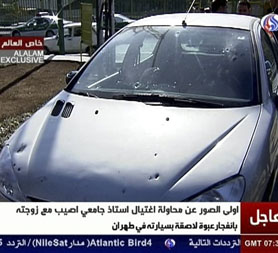Murdered Iranian scientist linked to UNESCO
An Iranian scientist who was killed in a bomb explosion in Tehran today was on an Iranian UNESCO team, Channel 4 News has learned.

This morning, Majid Shahriari, a lecturer at Shahid Beheshti University in Tehran was killed in his car, and his wife was wounded when two people drove by on motorcycles and attached the bombs, which then exploded, as the cars were moving.
In a separate incident today, Mr Shahriari’s colleague, Fereidoun Abbasi and his wife were also wounded in an identical attack.
Officials said they were both in a stable condition in hospital, as was Mr Shahriari’s wife.
Mr Shahriari was part of Iran’s team in Synchrotron-light for Experimental Science and Applications in the Middle East (SESAME), a United Nations scientific programme based in Jordan, and is listed as a professor of Nuclear Engineering at Shahid Beheshti.
The attacks took place this morning when the two professors were on their ways to the University in north Tehran.
Officials said Mr Shahriari was killed instantly.
Iran’s warning
Iran’s nuclear chief, Ali-Akbar Salehi, warned the West and its allies not to “play with fire” and vowed that Tehran would continue to expand its nuclear project.
Some Iranian media reported that the Mr Abbasi was a laser expert at Iran’s Defence Ministry and one of the country’s few top specialists in nuclear isotope separation and a member of the Revolutionary Guard, the country’s most powerful military force.
The SESAME council, which was found in 2004 in Jordan, sees researchers from many Middle Eastern nations including Iran, Pakistan,Jordan, Egypt, Morocco, Israel and the Palestinian Authority, working together on various projects.
It is based in Jordan and in 2002 it launched a synchrotron – a form of an advanced particle accelerator.
The project enables scientists to learn about the structure and behavior of molecules, atoms and crystals for studies in protein research, drug development as well as bio-technology.
SESAME is chaired by legendary theoretical physicist Professor Sir Chris Llewellyn Smith, the former director general of Cern, who was instrumental in creating the Large Hadron Collider.
Sir Chris told Channel 4 News that he had never met Mr Shahriari, nor indeed heard of him before today.
He clarified that SESAME was not a nuclear organisation, saying: “Synchrotrons such as SESAME are not in any sense nuclear facilities: they are accelerators that are designed to produce intense light with wavelengths ranging from the infra-red to X-rays, which are used to study matter on scales ranging from biological cells to atoms.
“The SESAME members have joined because their scientists want to use SESAME to carry out research in fields that include archaeology, biology, chemistry, environmental science, geology, and medicine.”
Another member of Iran’s SESAME team, Massoud Ali-Mohammadi, was killed on January 12.
He was assassinated on the doorstep of his home in the north Tehran district of Ghaytarieh.
A bomb reportedly concealed in a motorcycle parked next to his car was detonated by remote control.
Mr Mohammadi was considered an expert on particle and theoretical physics.
A number of world powers suspect Iran is trying to make nuclear weapons, an allegation the government denies.
The latest assasination of an Iranian scientist came a day after whistleblower website, WikiLeaks, released confidential State Department documents quoting several Arab leaders as urging the United States to attack Iran’s nuclear facilities.
There is no known connection between his participation in SESAME and the assassination.